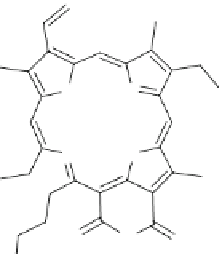Biomedical Engineering Reference
In-Depth Information
Pc
4 molecules. This was confirmed by drug release experiments in a water-toluene
two-phases system which showed that the release of
Pc
219 was >> 10 times slower
and very few
Pc
219 molecules were detected in HeLa cells. This is due to the low
dissociation of the
Pc
219 molecules from the AuNPs. Moreover, the AuNP-
Pc
219
conjugates did not show appreciable phototoxicity. Compared to the system with
Pc
4 molecules, a different cellular uptake pathway and a different localization were
observed with AuNP-
Pc
219 conjugates. Thiolated
Pc
219 molecules are located in
cell vesicles formed by the uptake of the AuNP-
Pc
219 conjugates. Moreover, the
AuNP-
Pc
219 conjugates did not show appreciable phototoxicity. The absence of
PDT effect observed with these AuNP-
Pc
219 conjugated was explained by the
formation of these vesicles containing the AuNP-
Pc
219 conjugates. These results
highlighted the importance of the nature of interactions between the nanocarriers
and the drug to the delivery and efficacy of a cancer drug.
2.2
Purpurin-18 and 5-Aminolevulinic Acid Gold
Nanoparticles Conjugates
Purpurin-18 is a chlorin molecule, i.e. a porphyrin derivative in which one pyrrole
is reduced, extracted from the green algae
Spirulina maxima
and possessing a car-
boxylic acid function. By treating this molecule with choline hydroxide,
Demberelnyamba et al. obtained the cholinium-purpurin-18-carboxylate salt
(Demberelnyamba et al.
2008
) (Fig.
5
). This water-soluble photosensitizer was
coupled to synthesize AuNPs without adding any particular reducing agents and
CTAB. Here, the purpurin acted both as a reducing and a protective agent. These
systems are also promising candidates for further PDT applications. Thus, weak
interactions such as electrostatic interactions can be used to obtain PS-AuNPs con-
jugates. An interesting example has been reported by Oo et al. (
2008
). In PDT, an
alternative to the administration of exogenous photosensitizers is to stimulate the
cellular synthesis of endogenous ones. 5-Aminolaevulinic acid (5-ALA, Fig.
6
) is
a metabolic precursor in the biosynthesis of haem and protoporphyrin IX PpIX
NH
N
OH
HN
N
N
O
O
O
Fig. 5
Cholinium-purpurin
18 (Chol-Pu-18)
O
2
C










Search WWH ::

Custom Search